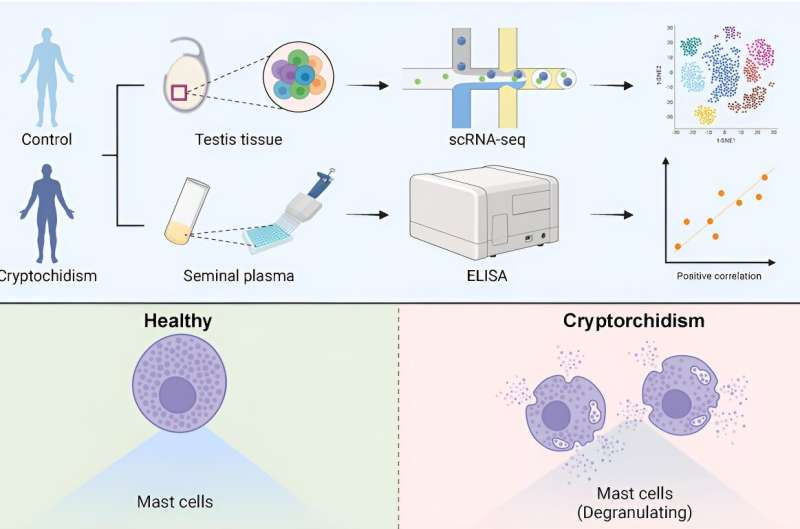This article has been reviewed according to Science X's editorial process and policies. Editors have highlighted the following attributes while ensuring the content's credibility:
fact-checked
peer-reviewed publication
trusted source
proofread
Study deciphers pathological mechanisms of spermatogenic impairment in cryptorchidism

Cryptorchidism is a common congenital abnormality in male newborns. Studies have found that cryptorchidism is associated with a high prevalence of male infertility, with nearly 10% of men with fertility problems having a history of cryptorchidism. However, the pathogenesis of cryptorchidism that leads to male infertility in adulthood has yet to be fully understood.
Prof. Guo Jingtao from the Institute of Zoology of the Chinese Academy of Sciences, collaborated with researchers from the Peking University Third Hospital and Peking University First Hospital, carried out systematic studies in their recent study to decode the pathogenesis of spermatogenic failure in cryptorchidism.
The research is published in the journal Cell Reports Medicine.
A total of 46 adult patients with cryptorchidism were included in this study through single-cell transcriptomic sequencing of testicular tissue, histologic validation, and seminal plasma secretory protein assay.
Results showed that in cryptorchidism, the impairment of spermatogenesis is mainly due to problems with the self-renewal and differentiation of spermatogonia.
Researchers also looked into the role of other cells in the testes, including immune cells, and found that mast cells are activated and release certain molecules that contribute to testis fibrosis.
Moreover, elevated levels of certain proteins in the seminal plasma, such as chymase, CXCL8, and PINP, indicate mast cell activation and fibrosis in the testes of individuals with cryptorchidism.
These findings offer valuable insights into the development of testicular disease and can aid in medical decision-making for cryptorchidism.
"We believe that the cutting-edge omics technology can help us extensively investigate the pathophysiological mechanisms of male infertility, discover new target molecules, and provide important guidelines for developing personalized and graded diagnosis and treatment strategies," said Prof. Guo.
The team will use artificial intelligence to identify, characterize, and simulate clinical differences in individual male infertility patients. Future studies will aim to pinpoint new intervention mechanisms and targets, so as to facilitate research and development as well as clinical practice for high-quality innovation translation, according to Prof. Guo.
More information: Xiaoyan Wang et al, Decoding the pathogenesis of spermatogenic failure in cryptorchidism through single-cell transcriptomic profiling, Cell Reports Medicine (2024). DOI: 10.1016/j.xcrm.2024.101709

















